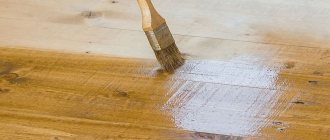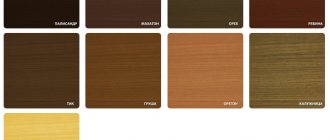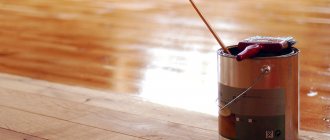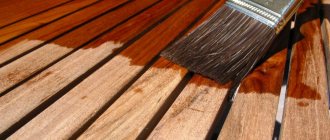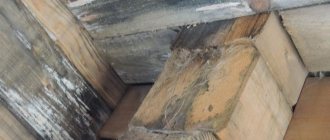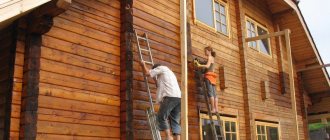A characteristic feature of wood is its tendency to quickly absorb moisture .
To prevent this process, paint or varnish is used. The advantage of the latter option is the fact that the surface treated in this way retains its natural beauty .
Recently, ship varnish for wood, specially designed for use in conditions of constant humidity, has gained particular popularity. It is also called yacht.
Where is yacht varnish used?
Most often, yacht varnish for wood was used in shipbuilding. A layer of varnish was applied to the outside of the vessel. It was dangerous to do this inside due to the toxic reaction of the substance.
The product turned out to be effective due to its water resistance and availability. In modern times, varnish is used not only for the above-mentioned purposes.
The product has found demand among varnishing parts that:
- Subject to stress;
- Are exposed to the environment;
- Used for internal and external repairs;
The use of yacht varnishes plays a protective role. A kind of modified film is formed, thanks to which the processed material is reliably protected from moisture, solar heating, mechanical or physical damage.
There are a number of items that can be coated with urethane yacht varnish: furniture, parquet, musical instruments, etc.
Briefly about the main thing
Yacht varnish, an invention of shipbuilders, has taken a strong place among finishing materials for the residential sector. The chemical composition determines its unique properties: moisture resistance, wear resistance, strength and an impressive finishing result. The volatile substances of the benzene group included in the varnish negatively affect health.
Ship varnishes are usually divided into groups according to the main substance included in the formula. There are four groups on sale with different characteristics and degrees of toxicity. When choosing the optimal product, it is necessary to take into account the scope of its application and the degree of light reflection.
What are the advantages of yacht varnish?
Glossy yacht varnish has a number of privileges, which are described in the following paragraphs:
- Quickly adheres to the surface of the material and remains there for a long time. Thanks to instant absorption, the substance acts for a long period of time.
- Alkyd yacht varnish protects against penetration of sunlight and possible damage to the film. Due to the content of special components and stabilizers, radiation is absorbed. Ultraviolet rays are converted into heat. This way the film remains undamaged.
- A beautiful appearance is formed, which naturally attracts everyone's attention. And who doesn’t like the well-groomed appearance of products?
- An increased level of moisture resistance guarantees freedom from rot, mold and mildew.
- The long service life of the product, which is coated with a special varnish, is guaranteed. Possible scratches or chips are prevented.
- It is easier to care for furniture if the product has a protective varnish film. In this case, it is quite reasonable to use household chemicals.
- The varnish increases the elasticity of the coating, which avoids damage and cracking.
- The products are available to most consumers at a reasonable price. Thanks to the pricing policy, the product is gaining more and more demand.
General characteristics
The special material contains harmful substances, so it is recommended to carry out finishing in a room with constant access to fresh air. Finishing protects wooden elements from moisture, which extends their service life. When using special materials, the aesthetics of wood will be improved.
Yachtlak is used to process house facades and country furniture, to furnish wooden baths and saunas, to cover wooden floors, and to varnish musical instruments. Special deck material is a reliable and durable finish that has protective properties and is characterized by ease of coating.
Cons of yacht varnish
Yacht varnish passes the frost test negatively. Unfortunately, the substance does not tolerate low temperatures well. From a safety point of view, it contains many negative components that are dangerous to humans.
- Manufacturers justify the addition of toxic substances by the increased characteristics of the product.
- However, the toxicity of varnishes still remains a significant drawback.
- For example, xylene and toluene poison the human body through the air.
- When working with this material, pay attention to safety rules. Otherwise, irreparable harm will be caused to the body.
- Cross-ventilation and the use of respirators are strongly recommended.
However, technological progress allows the use of such a product even indoors. Acrylic varnish is not as toxic due to its water-based production.
Peculiarities
Possessing high resistance to the aquatic environment, yacht mixtures from the very beginning were intended for coating the hulls of river and sea vessels. High water-resistant characteristics are ensured by a very harmful toxic composition in the form of two elements - toluene and xylene. They have a detrimental effect on the body. This does not always stop the consumer; they begin to use the material indoors.
- Toluene is a highly volatile benzene compound based on hydrogen and carbon. Harm is caused to humans by inhaling its toxic fumes. Signs of poisoning include dizziness, irritation of the mucous membranes of the nose and eyes, and in severe cases, swelling of the lungs. Toluene acts slowly due to weak evaporation, but prolonged exposure is very dangerous.
- Xylene affects humans not only through the respiratory system, but also through the skin (enters through the pores). The symptoms of poisoning are pronounced; with prolonged exposure to xylene, a person becomes very tired, experiences stress, and in the worst cases, the internal systems of the body are affected, and cancer formations are formed.
Price, quality indicators and the manufacturer cannot protect you from the dangers of yacht varnish on the body. The harmful effects are due to the composition of the varnish necessary to ensure technical characteristics. It is recommended to use ship varnish only for external use.
Benzene compounds are lighter than air; upon evaporation, they immediately rise upward, without having a toxic effect on the body, or having a minimal effect. Despite this, personal protective equipment is mandatory.
Variety of coatings
There is a wide range of products on the market, which naturally makes it difficult for the consumer to choose. In this case, you should start from the composition, properties and appearance of the material.
To determine which yacht varnish is better, pay attention to a number of varieties:
- Alkyd. Wear-resistant varnish at an inexpensive cost. Due to its price and adequate quality, it has received great demand among buyers. The key disadvantage is the inability to use in the interior area of the room due to toxicity.
- Urethane-alkyd. It also contains toxic components, but not in large quantities. Therefore, it is permissible to work with such a substance indoors. The material differs from the previous version due to its heat-resistant film. Effectively used in combination with heated floors. During operation, you can not be afraid of the occurrence of possible microcracks.
- Alkyd-urethane. Dries quickly and easily withstands temperature changes. However, the high level of toxicity of the product does not allow working with it in a confined space.
- Acrylate. Due to water-based production, the substance is less toxic. This is a safe product during use and during drying. Although the varnish is called “yacht”, it is not recommended to use it where there is a lot of moisture.
Varnishes are also divided into separate categories based on light reflectivity:
- Glossy looks beautiful and reflects light well. However, it requires careful care. An ideal smooth surface easily becomes dirty without proper care.
- Matte does not look as good, but hides possible imperfections due to dirt or damage.
- There are product options called semi-matte or semi-gloss.
Conditions of use and product types
Yacht varnishes are sold in sealed jars or cans. Aerosol is somewhat more convenient to use.
Using a sprayer, it is easy to apply a uniform dispersed layer without exceeding the recommended coating thickness. The disadvantage of aerosols is that they are sold in small containers, and, in terms of calculation, turn out to be much more expensive than a simple can. The glossy, decorative layer is much more convenient and beautiful to apply from a spray can, while the matte, protective layer can be applied with a brush or roller.
You should choose yacht varnishes for interior decoration with extreme caution, giving preference to well-known manufacturers. Finnish varnish Tikkurila, which is among the leaders in sales of such products, is popular precisely because of the significant efforts made to minimize the harmful effects of using their products. Tikkurila matte varnish is made on a urethane-alkyd basis and has analogue-free resistance to precipitation, but is also successfully used for interior decoration.
The building materials market is flooded with various protective varnishes, on the labels of which manufacturers have found it necessary to write the word yacht as an additional marking of the stability and reliability of the polymer film created with the product. But yacht varnish is a special category of building materials, in the choice of which you should exercise caution and caution.
How to apply yacht varnish
The operation of the varnish provides a set of rules, which guarantees safety and efficiency.
- Carefully clean the surface of the product, eliminating any unevenness and unnecessary elements.
- Temperature requirements are from +150 to +35 degrees C. The required air humidity is 80%. Use a roller, brush or spray.
- Be sure to dry the wood so that moisture levels do not exceed 20%.
- The surface needs a primer before applying varnish.
- The substance is applied in two or three layers.
- Minimum four hours for the varnish to dry. If the substance is not dry, it will be sticky when touched. In this case, the next layer cannot be applied until the previous one has dried.
While working, use construction gloves and a respirator. Finally, be sure to ventilate the room.
Varnish is flammable! You shouldn't throw it down the drain.
Carrying out painting work
Before applying the varnish composition to the floor or other surfaces, fresh boards should be thoroughly cleaned, sanded, and debris removed. Before starting work, stir the liquid, bring it to homogeneity, and, if necessary, dilute with white spirit or another solvent that is ideal for varnish.
The coating should be applied with a roller, brush or using a special paint sprayer. Work should be carried out only at positive air temperatures in the atmosphere - from 15 to 30 degrees and an average level of humidity. In this case, be sure to protect your hands and respiratory organs. For outdoor wood processing, you should choose warm, but not at all hot weather, and there should be no strong wind or precipitation.
When the wooden surface is cleaned, it should be treated with a 20% diluted varnish or other suitable primer mixture. When the bottom layer has dried, the material should be sanded again using fine abrasive paper and any identified roughness should be removed, and then a new layer of undiluted varnish should be applied.
Depending on how tight your finish is, you may need to apply two or even three coats. If the wood has previously been varnished, then the old coating should be removed only when it is cracked. And if you just need to update everything, then first try the department in an inconspicuous small area.
If within a few days after drying the varnish does not begin to peel off and swell, then it will be possible to cover the entire surface with it in a couple of layers, and each subsequent one can be applied only after the bottom one has dried. The drying time for the material will be approximately 4 to 8 hours. Between applications, you can sand with an abrasive for strength.
The consumption of deck varnish per square meter is approximately 0.1 kg. For successful drying, it is necessary to protect the surface from direct rays of the sun, heating from electrical appliances and moisture. The coating will completely harden in 4 to 7 days. Under no circumstances should any remaining material be stored in the cold or near heating devices, and it is also prohibited to pour it down the drain.
